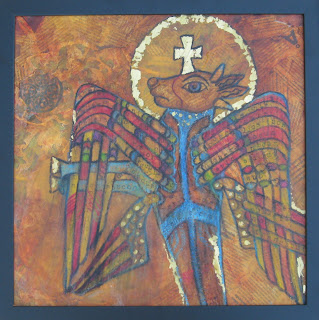



I love the imagery in illuminated manuscripts- the brilliant and faded colors, the gold, the flat patterning, the fanciful beasts. I like to think about the monks who made them so patiently and the love and devotion that went into their creation. I've learned that most of the monks were literate, but not all , so it is possible to find mistakes as some copied words that they didn't understand. And to think of who owned these books. Some were owned by wealthy people who possessed them as status symbols. Some were to grace altars, to be read on special occassions. Some were plundered in wars and stripped of their valuable jeweled bindings. I think of the words they contained, written in Latin and how common people who attended the mass might not understand what was being said, but they would be comforted anyway. Thinking about... a knowing that transcends language.When I made this series I was also looking for a way to express what Rilke says in his advice to a young poet-to not look for answers. To paraphrase: "Love the questions- as if they were locked rooms and books written in a very foreign language- you wouldn't understand the answers if they were given to you- live into the questions and someday you will find yourself living the answer". These pieces are collaged with bits of newspaper and wax (which was the surface used by Romans to write everyday correspondence) to show the ephemeral nature of words, past and present. The newspapers are in Swedish, French, Spanish and Russian- a very foreign language to me. The images are taken from the Book of Kells to represent the enduring power of Spirit- which is ineffable.
These four mixed media pieces represent the four saints. Traditionally, Matthew is symbolized by man, Mark by the lion, Luke as the ox and John as the eagle.
From Catholic Forum.com : "The reasons for this assignment are usually explained by saying that the more human symbol is appropriate to the Evangelist who traces the human ancestry of Christ; the Lion to him whose gospel of Jesus Christ begins with" the voice of one crying in the wilderness;" the Ox to him who writes especially of the priesthood and of sacrifice, of which the ox is symbolical; and the Eagle to him whose inspiration soared to the loftiest heights, and enabled him to reach the paramount human perception of the dual nature of Jesus Christ."
I have become very interested in ecclesiastical art lately. The act of making art as prayer is a concept that is common in all the great religions of the world and a transcendent experience.
No comments:
Post a Comment